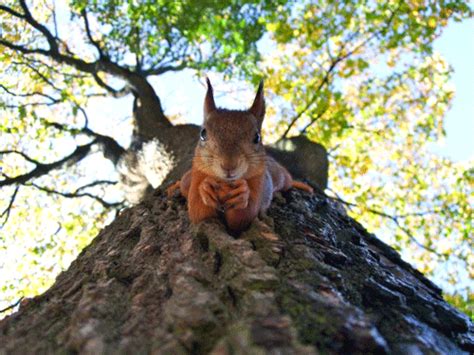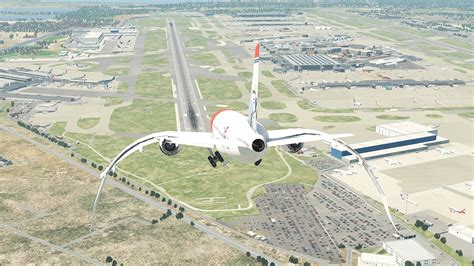
Squirrels across several states are exhibiting unusual behaviors, including premature nut gathering and erratic actions, prompting concerns among wildlife experts and officials. The early gathering of nuts, weeks ahead of schedule, coupled with reports of squirrels appearing disoriented and unusually docile, has raised questions about potential environmental factors or diseases affecting the animals.
Wildlife officials are urging residents to observe squirrel behavior and report any abnormalities as they investigate the cause of these unusual patterns. The early harvesting of nuts by squirrels could have broader implications for local ecosystems, affecting tree propagation and the food supply for other wildlife species during the winter months.
The reports have come in from various locations, including areas in the Northeast and Midwest, with officials noting that while squirrel behavior can naturally vary from year to year, the current deviations are significant enough to warrant closer scrutiny. “We’re seeing squirrels burying nuts much earlier than usual,” stated a wildlife biologist familiar with the situation, “and this, coupled with the reports of strange behavior, suggests something is impacting them.”
Theories being explored include the impact of climate change on food availability, the presence of toxins in the environment, and potential viral or bacterial infections that could be affecting the squirrels’ neurological functions. Public cooperation is essential in monitoring the situation and providing data that can help researchers understand and address the issue. Residents are advised to avoid direct contact with squirrels exhibiting unusual behavior and to report their observations to local wildlife authorities.
Unusual Squirrel Behavior Sparks Concern
Wildlife experts are sounding the alarm over unusual squirrel behavior observed across multiple states. Reports indicate squirrels are gathering nuts far earlier than normal and displaying odd actions, including disorientation and unusual tameness. This has triggered an investigation into potential causes and broader ecological impacts.
The early nut gathering, occurring weeks ahead of the typical schedule, is a key indicator of the unusual behavior. Squirrels are instinctively driven to stockpile food for the winter months, but the premature nature of this activity suggests a possible disruption in their natural cycles. This could be related to perceived changes in food availability or environmental cues influencing their behavior.
Beyond the early harvesting, reports of erratic behavior are adding to the concern. Residents have described squirrels appearing disoriented, struggling with basic tasks, and displaying a surprising lack of fear around humans. Such behaviors could indicate a variety of underlying issues, ranging from neurological problems to exposure to toxins.
“We’re not sure what’s causing this,” explained Dr. Emily Carter, a wildlife veterinarian involved in the investigation. “It could be a number of factors, including changes in food supply, exposure to toxins, or even a disease outbreak. We need more data to determine the root cause.”
Wildlife officials are calling on the public to assist in monitoring the situation by reporting any unusual squirrel behavior they observe. This information can help researchers track the extent of the problem and identify potential hotspots where intervention may be necessary.
Potential Causes Under Investigation
Several potential factors are being investigated as possible causes of the unusual squirrel behavior. These include:
- Climate Change Impacts: Climate change is known to disrupt natural cycles and affect food availability for wildlife. Changes in temperature and precipitation patterns could be influencing when trees produce nuts and impacting the squirrels’ ability to find and store food. Irregular weather patterns, such as early frosts or droughts, could create stress for the squirrels, affecting their behavior.
- Environmental Toxins: Exposure to toxins in the environment is another concern. Pesticides, herbicides, and other pollutants can accumulate in the soil and water, potentially affecting the squirrels through their food supply. Some toxins can have neurological effects, leading to disorientation and erratic behavior. Industrial pollutants and runoff from agricultural areas are also being examined as potential sources of contamination.
- Disease Outbreak: Viral or bacterial infections could also be responsible for the unusual behavior. Squirrels are susceptible to a variety of diseases, some of which can affect their neurological functions. Rabies, although rare in squirrels, is a potential concern, as are other less common diseases that could be circulating in the population.
- Food Scarcity: A lack of natural food sources could drive squirrels to harvest nuts prematurely out of desperation. Deforestation, habitat loss, and competition from other species can reduce the availability of acorns, nuts, and other food sources, leading squirrels to alter their behavior.
- Parasites: External or internal parasites can also impact squirrel behavior. Mites, fleas, and ticks can cause discomfort and irritation, while internal parasites can affect nutrient absorption and overall health. Heavy parasite infestations can lead to lethargy, disorientation, and other behavioral changes.
Ecological Implications of Early Nut Gathering
The early nut gathering by squirrels could have significant ecological implications. Squirrels play a crucial role in forest ecosystems by dispersing seeds and helping to regenerate trees. When squirrels bury nuts, some of them are forgotten and eventually germinate, leading to new tree growth.
If squirrels are harvesting nuts too early, it could affect the viability of the seeds and reduce their ability to germinate. Premature nuts may not be fully developed and could lack the necessary nutrients to support seedling growth. This could have long-term impacts on forest regeneration and the composition of tree species.
In addition, the early nut gathering could disrupt the food supply for other wildlife species that rely on nuts during the winter months. Birds, deer, and other animals also consume nuts and acorns, and if the squirrels have already depleted the supply, it could lead to food shortages and increased competition. This could have cascading effects on the entire ecosystem, impacting predator-prey relationships and the overall health of the wildlife population.
The impact of the change will not be distributed equally. Some species are more adaptable than others. For example, if the squirrels are unable to harvest nuts efficiently, then opportunistic species like raccoons may benefit from easier access to unattended food sources, leading to changes in population dynamics and interspecies competition.
Public Response and Monitoring Efforts
Wildlife officials are urging residents to be vigilant and report any unusual squirrel behavior they observe. This includes squirrels that appear disoriented, unusually tame, or are gathering nuts far earlier than normal.
“The public plays a critical role in helping us monitor this situation,” said Mark Johnson, a wildlife specialist. “By reporting their observations, they can provide valuable data that will help us understand the extent of the problem and identify potential causes.”
Residents are advised to avoid direct contact with squirrels exhibiting unusual behavior and to keep their pets away from them. If a squirrel appears to be sick or injured, it should be reported to local wildlife authorities. It is also important to avoid feeding squirrels, as this can encourage them to become dependent on humans and disrupt their natural foraging behavior.
Wildlife agencies are working to track reports, collect samples, and conduct research to determine the cause of the unusual squirrel behavior. They are also collaborating with other experts, including veterinarians, ecologists, and toxicologists, to gather information and develop a comprehensive response plan.
Historical Context of Similar Events
While the current situation is concerning, it is not the first time that unusual animal behavior has been reported. Throughout history, there have been instances of wildlife exhibiting strange actions, often linked to environmental factors, disease outbreaks, or human activities.
In the past, mass die-offs of birds, fish, and other animals have been attributed to pollution, habitat loss, and climate change. Disease outbreaks, such as West Nile virus and avian flu, have also caused widespread mortality and behavioral changes in wildlife populations.
These historical events serve as a reminder of the interconnectedness of ecosystems and the potential for human activities to disrupt natural cycles. They also highlight the importance of monitoring wildlife populations and taking steps to protect their health and habitat.
Some historical accounts describe similar, though localized, instances of squirrel populations behaving erratically, particularly following periods of extreme weather. For example, after severe droughts, squirrels have been observed venturing into urban areas in search of food, exhibiting unusual boldness and aggression. These past occurrences provide valuable context for understanding the current situation and developing effective management strategies.
The Role of Citizen Science
Citizen science initiatives are playing an increasingly important role in monitoring wildlife populations and collecting data on environmental changes. These programs involve volunteers who assist scientists in gathering information, analyzing data, and reporting their observations.
In the case of the unusual squirrel behavior, citizen science programs can help to track the distribution of affected animals, monitor their behavior, and collect samples for analysis. Volunteers can also assist in educating the public about the issue and promoting responsible wildlife interactions.
By engaging the public in scientific research, citizen science programs can increase awareness of environmental issues and empower individuals to take action to protect wildlife. They also provide valuable data that can help scientists to better understand and address complex ecological problems.
One example of a successful citizen science project is the Cornell Lab of Ornithology’s eBird program, which allows birdwatchers to submit their sightings and contribute to a vast database of bird distribution and abundance. This data is used by scientists to track bird populations, monitor migration patterns, and assess the impacts of climate change and habitat loss.
Long-Term Impacts and Mitigation Strategies
The long-term impacts of the unusual squirrel behavior are still uncertain, but they could be significant. If the early nut gathering affects tree regeneration or disrupts the food supply for other wildlife species, it could have cascading effects on the entire ecosystem.
To mitigate these potential impacts, it is important to identify the underlying cause of the unusual behavior and take steps to address it. This could involve reducing pollution, protecting habitat, controlling disease outbreaks, or managing wildlife populations.
In addition, it is important to monitor the affected squirrel populations and assess the long-term impacts of the unusual behavior. This information can help to inform management decisions and ensure that conservation efforts are effective.
Some potential mitigation strategies include:
- Habitat Restoration: Restoring degraded habitats can provide squirrels with more food and shelter, reducing their vulnerability to environmental stressors.
- Pollution Reduction: Reducing pollution can improve the health of squirrels and other wildlife, making them less susceptible to disease and other problems.
- Disease Management: Implementing disease management strategies can help to control outbreaks and prevent the spread of infections.
- Public Education: Educating the public about responsible wildlife interactions can help to reduce human impacts on squirrel populations.
Ongoing Research and Future Directions
Research into the unusual squirrel behavior is ongoing, and scientists are working to gather more data and develop a better understanding of the problem. This research includes:
- Tracking: Wildlife agencies are using tracking technology to monitor the movements and behavior of affected squirrels.
- Sampling: Scientists are collecting samples of tissue, blood, and other materials to test for toxins, diseases, and other factors.
- Experiments: Researchers are conducting experiments to assess the effects of different environmental stressors on squirrel behavior.
- Modeling: Scientists are developing models to predict the long-term impacts of the unusual squirrel behavior on the ecosystem.
Future research will focus on identifying the specific factors that are causing the unusual behavior and developing effective mitigation strategies. This research will require collaboration among scientists, wildlife officials, and the public.
One area of particular interest is the potential role of neonicotinoid pesticides, which have been linked to neurological problems in insects and other wildlife. Scientists are investigating whether exposure to these pesticides could be contributing to the disorientation and erratic behavior observed in the squirrels.
Another area of focus is the potential impact of climate change on the timing of nut production. Researchers are studying how changes in temperature and precipitation patterns are affecting the phenology of trees and the availability of food for squirrels and other wildlife.
Conclusion: A Call for Vigilance and Action
The unusual squirrel behavior is a cause for concern, and it highlights the importance of monitoring wildlife populations and protecting their habitat. By working together, scientists, wildlife officials, and the public can help to understand the cause of this phenomenon and take steps to mitigate its potential impacts.
The situation serves as a reminder of the interconnectedness of ecosystems and the potential for human activities to disrupt natural cycles. It also underscores the importance of responsible environmental stewardship and the need to protect wildlife for future generations.
Continued vigilance, ongoing research, and proactive mitigation strategies are essential to ensure the health and resilience of squirrel populations and the ecosystems they inhabit. By staying informed and taking action, we can help to safeguard the natural world and ensure a sustainable future for all.
Frequently Asked Questions (FAQ)
-
What is causing the squirrels to act strangely?
- The exact cause is currently under investigation, but potential factors include climate change impacts on food availability, exposure to environmental toxins (such as pesticides), disease outbreaks affecting neurological function, food scarcity due to habitat loss, and parasite infestations.
-
What are the specific unusual behaviors being observed?
- The primary unusual behaviors include squirrels gathering nuts much earlier than the typical schedule and displaying erratic actions such as disorientation, unusual tameness or lack of fear around humans, and difficulty with basic tasks like climbing or foraging.
-
What should I do if I see a squirrel acting strangely?
- Avoid direct contact with the squirrel. Report the sighting to your local wildlife authorities or animal control, providing details about the location, the squirrel’s behavior, and any other relevant information. Do not attempt to feed or capture the squirrel.
-
Could this unusual behavior affect other wildlife or the environment?
- Yes, the early nut gathering could impact tree regeneration if the nuts are not fully developed and viable for germination. It could also disrupt the food supply for other animals that rely on nuts during the winter.
-
What is being done to address this issue?
- Wildlife agencies are tracking reports, collecting samples from affected squirrels for analysis, conducting research to determine the cause, and collaborating with experts such as veterinarians, ecologists, and toxicologists to develop a comprehensive response plan. They are also relying on citizen science reports to gather data on the extent of the problem.









